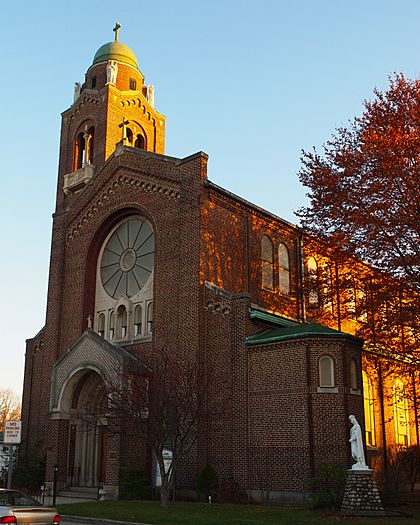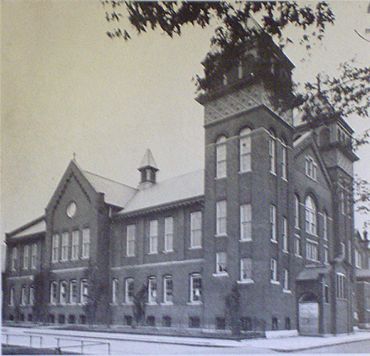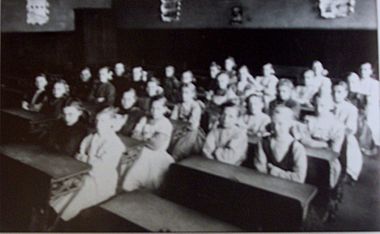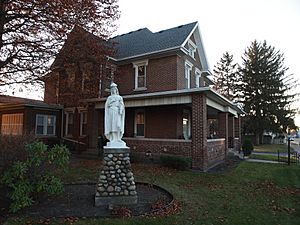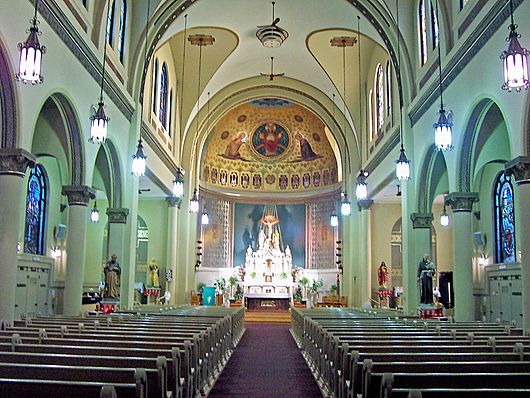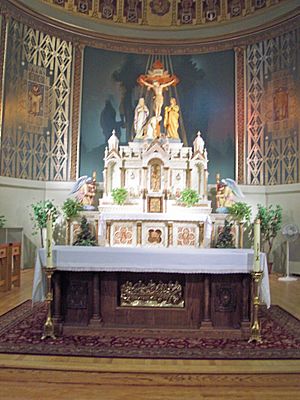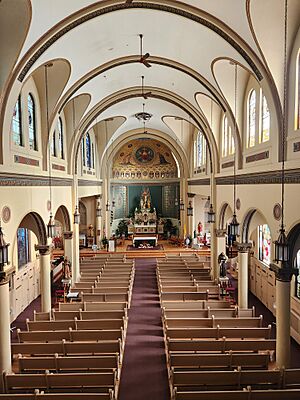St. Casimir Parish, South Bend facts for kids
Quick facts for kids St. Casimir Parish |
|
|---|---|
| Location | 1308 W. Dunham Street South Bend, Indiana |
| Country | United States |
| Denomination | Roman Catholic |
| Website | Parish website |
| History | |
| Founded | 1898 |
| Founder(s) | Polish immigrants |
| Dedication | St. Casimir |
| Dedicated | November 15, 1925 (Solemn blessing) |
| Consecrated | May 4, 1949 |
| Relics held | St. Casimir, St. Stanislaus, bishop and martyr, St. Andrew Bobola, St. Adalbert, St. Josaphat, St. Bernard |
| Administration | |
| Diocese | Fort Wayne-South Bend |
| Province | Indianapolis |
St. Casimir Parish is a Catholic church in South Bend, Indiana, United States. It was started in 1898. It is part of the Roman Catholic Diocese of Fort Wayne-South Bend. This church is an important building in the St. Casimir Parish Historic District.
You can attend weekend masses here. There is an English mass on Saturday at 4:00 p.m. (on the 2nd and 4th Saturdays of the month). On Sunday, there is an English mass at 9:30 a.m. and a Spanish mass at 11:30 a.m.
Contents
The Church's Beginning
St. Casimir Parish was founded in 1898 by people who had moved from Poland. It was the second of four Polish American churches in South Bend, Indiana. The first pastor was Rev. Anthony Zubowicz, C.S.C.
The new church began in a building that was both a church and a school. This building opened in March 1899. The main hall in the school was used as the church until the current church building was finished in 1924. The church is located at Dunham and Webster streets in South Bend. Priests from the Congregation of Holy Cross have served the parish since it started.
Rev. Valentine Czyzewski, C.S.C., was a very important person for the Polish community in South Bend. For 35 years, he helped lead their religious and social life. He helped start new churches, schools, and libraries. He also helped Polish workers with their problems. In 1893, he suggested that Polish people living on the south side of the Grand Truck Railroad tracks should start a new church.
By 1896, the neighborhood had grown. A committee was formed to start the new parish. On March 2, 1896, Bishop Joseph Rademacher visited the proposed site. He approved it, saying it was a "beautiful location." Construction of the combined school and church began in April 1898. Rev. Anthony Zubowicz, C.S.C., became the first pastor on June 11, 1898. The new church was blessed, and the first mass was held on March 4, 1899.
School Days at St. Casimir
The parish school opened in 1899. The Sisters of the Holy Family of Nazareth taught at the school. By 1910, about 600 students were enrolled in grades 1 through 8. Children attended morning mass and classes during the week. Classes were taught in both Polish and English.
Since the children lived nearby, they walked to school. They would go home for lunch and then return for afternoon classes. Children also attended a special Sunday morning mass for kids. They sat with their class and were sometimes asked questions by the priest afterward.
Challenges and Changes
In 1913, Fr. Czyzewski, a key Polish priest, passed away. Rev. Zubowicz moved to St. Hedwig Parish to take his place. Around this time, there were some disagreements at a nearby church, St. Adalbert. Some people left St. Adalbert to start a new church.
Soon after, Rev. W.T. Szalewski, C.S.C., became the pastor of St. Casimir. Some parishioners were unhappy with this choice. They wanted the assistant pastor, Rev. Leon P. Szybowicz, C.S.C., to be the new leader. Because of these ongoing disagreements, Rev. Szalewski left the parish in October 1913. Rev. Szybowicz was also removed because he had encouraged parishioners to support him. The church was closed from October 1913 to February 1914.
On February 15, 1914, an event called "Krwawa Niedziela" or "Bloody Sunday" happened. Rev. Stanislaus Gruza, C.S.C., arrived to become the new pastor. A large crowd of over 1,000 people gathered. When police tried to help Father Gruza enter the rectory, a conflict occurred. Many people were hurt during this event.
After this, the bishop obtained a court order. Twenty-eight people were arrested. In late March, Father Gruza was able to take over the parish. However, many parishioners did not want to work with him. The legal issues were resolved, and charges were dropped in the following months. In the summer of 1915, Father Gruza left the parish. Rev. Stanislaus Gorka, C.S.C., became the new pastor without any problems. The memory of the conflict stayed with Father Gruza for his whole life.
Rebuilding and Growth
Under the leadership of Rev. Stanislaus Gorka, C.S.C., the parish began to heal. Most of the upset parishioners returned. In the 1920s, a new church building was constructed at Dunham and Webster Streets. This new church became a great source of pride for the parish. Bishop John F. Noll blessed the church on November 15, 1925.
Many men in the parish worked in factories nearby. Companies like Studebaker and Oliver Farm Equipment Company employed thousands of workers. However, during the economic difficulties of the early 1930s, many people lost their jobs. This made it hard for the church to pay its bills until the 1940s. Father Gorka sometimes had to ask local shops for small donations to help the church.
In 1949, the parish celebrated its 50th anniversary. Since the church's debt was paid off, it was officially consecrated by Bishop Roman R. Atkielski on May 4, 1949. At this time, the school had 290 students. The parish also had over 20 clubs and groups for church service, spiritual growth, youth activities, sports, and community improvement.
Since the 1960s, the neighborhood around the church has changed. It became a mix of different cultures, including Mexican, Polish, and Black families. The city's population also decreased. In 1975, Rev. Leo Wojciechowski, C.S.C., closed the parish school. Many parishioners disagreed with this decision. The school had 156 students, but Father Wojciechowski felt there was not a strong future for it.
In 1994, St. Casimir Parish began sharing its priests with St. Stephen Parish. Rev. Thomas Lemos, C.S.C., became the pastor for both. From 1997 to 1998, the parish celebrated its 100th year. There were many events, including parades, festivals, and a school reunion. The celebrations started and ended with a special 40-hour prayer event near St. Casimir's feast day on March 4.
In 2003, St. Stephen Parish merged with St. Adalbert Parish, South Bend. Since then, St. Casimir Parish has shared its pastor and priests with St. Adalbert Parish. In 2005, a Spanish language mass was added, which has helped the church grow. From 2005 to 2018, the former rectory (priest's house) was a home for the Felician Sisters. In 2009, the parish offices for both St. Adalbert and St. Casimir moved to a shared building at St. Adalbert. Rev. Paul Ybarra, C.S.C., was pastor from 2016 to 2020. The current pastor, Rev. Ryan Pietrocarlo, C.S.C., began his service in July 2020.
Church Design
The church was designed by Worthmann and Steinbach. It is built in the Polish Cathedral style. It has Romanesque architecture with beautiful Italian-style chandeliers. The inside of the church, with its arches along the sides and a large arch around the main altar, looks a bit like St. Paul's Within the Walls in Rome.
The outside of the church is made of red brick in a traditional Polish style. Because of its beautiful and detailed design, the St. Casimir church building has a very high historical architectural ranking. It is one of only a few buildings in South Bend with this special recognition.
Parish Culture
St. Casimir Parish celebrates its Polish American background in many ways. One special event is the annual Micholaj celebration, a Polish dinner feast. On the evening before the Feast of St. Nicholas, the parish enjoys traditional foods like pierogi, noodles, roast beef, and special pastries called paczkis. After the meal, people sing "kolendy," which are Polish Christmas carols. Then, St. Nicholas visits the children, bringing them fruit, candy, and prayer cards.
St. Casimir also celebrates Forty Hours' Devotion each year for the feast day of its patron saint, St. Casimir, on March 4.
Past Leaders
- Rev. Anthony Zubowicz, C.S.C. (July 1898–April 1899)
- Rev. Eligius Raczynski, C.S.C. (April 1899-June 1902)
- Rev. Anthony Zubowicz, C.S.C. (June 1902-July 1913)
- Rev. Mieczyslaw Szalewski, C.S.C. (July 1913-August 1913)
- Rev. Boniface Iwaszewski, C.S.C. (August 1913-October 1913)
- Rev. Mieczyslaw Szalewski, C.S.C. (October 1913)
- Rev. Stanislaus Gruza, C.S.C. (January 1914-September 1915)
- Rev. Stanislaus Gorka, C.S.C. (September 1915-July 1931)
- Rev. Anthony Rozewicz, C.S.C. (July 1931-July 1937)
- Rev. Stanislaus Gorka, C.S.C. (July 1937-August 1941)
- Rev. Boleslaus Sztuczko, C.S.C. (October 1941-July 1946)
- Rev. Casimir Witucki, C.S.C. (July 1946-June 1957)
- Rev. Bernard Niemier, C.S.C. (July 1957-June 1964)
- Rev. George Szymanowski, C.S.C. (July 1964-June 1975)
- Rev. Leo Wojciechowski, C.S.C. (July 1975-June 1978)
- Rev. Howard A. “Gus” Kuhns, C.S.C. (July 1978-June 1987)
- Rev. Joseph H. Fey, C.S.C. (July 1987–June 1994)
- Rev. Thomas F. Lemos, C.S.C. (July 1994–June 2001)
- Rev. David J. Porterfield, C.S.C. (July 2001–June 2004)
- Rev. Christopher W. Cox, C.S.C. (July 2004–June 2010)
- Rev. Peter J. Pacini, C.S.C. (July 2010–June 2016)
- Rev. Paul Ybarra, C.S.C. (July 2016 – June 2020)
- Rev. Ryan Pietrocarlo, CSC (July 2020 – Present)


